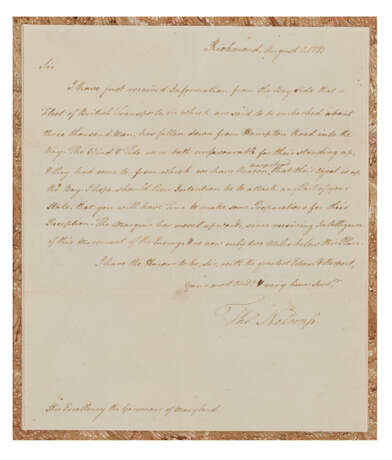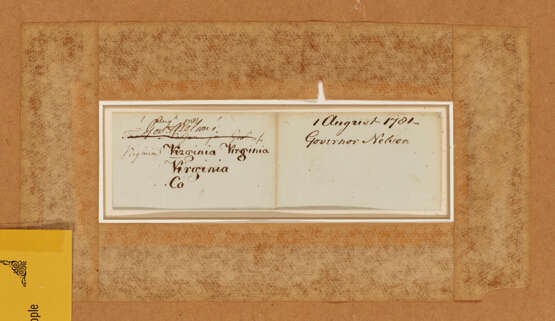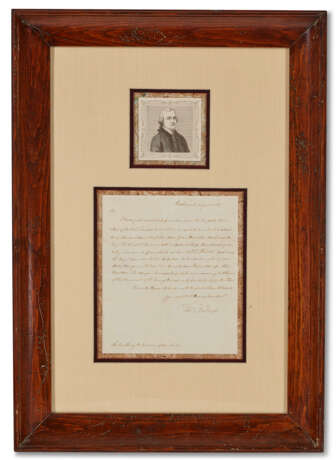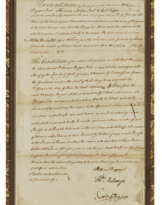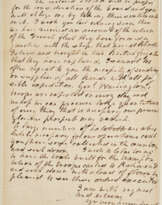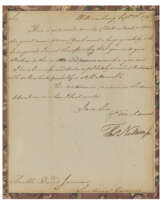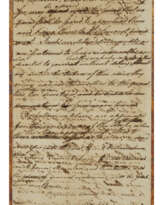ID 1236367
Lot 136 | Reporting on the first British moves to occupy Yorktown and Gloucester
Valeur estimée
$ 7 000 – 10 000
One page, 180 x 210mm, with integral address leaf, docketed by Thomas Sim Lee and one other unidentified (some small spots of browning). Matted and framed with an engraved portrait.
Nelson sends intelligence of Cornwallis's movement to occupy Yorktown and Gloucester Point--mistaking it for a possible British advance against the upper Chesapeake and reporting on Lafayette's response. Writing from Richmond, the newly-appointed governor of Virginia writes to his counterpart in Annapolis reporting having "just received Information form the Bay Side that a Fleet of British Transports, in which are said to be embarked about three thousand men, has fallen down from Hampton Road into the Bay." Although unfavorable tides prevented them from proceeding further, he still had "Reason to apprehend that their Object is up the Bay. I hope, should their Intention be to attack any Part of your State, that you will have Time to make some Preparations...The Marquis has moved upwards, since receiving Intelligence of this Movement of the Enemy & is now only two Miles below this Place."
The beginning of the end for Cornwallis. Nelson and Lafayette would soon learn their mistake. Rather than moving into Chesapeake Bay, the embarked British troops were making their way to establish new posts at Yorktown and Gloucester Point. Cornwallis had marched from the Carolinas to the Virginia Tidewater to resupply for renewed campaigning in Virginia after suffering a pyrrhic victory over Greene at Gilford Courthouse, but his plans would be thwarted by James Clinton in New York who wished to see a strong naval base established in the Chesapeake. To this end, Clinton ordered Cornwallis to cease all movements into Virginia and to "hold Old Point Comfort which secures Hampton Road" at the mouth of the James River together with an additional post at Yorktown. Even when Cornwallis's engineers concluded that Old Point Comfort was unsuitable for a naval base, Clinton emphasized that fortifications must be constructed at both locations, adding that that three thousand men should be sufficient to the task. After receiving further letters from Clinton about the issue, Cornwallis still refused to consider Old Point Comfort as a viable option; instead, he and his forces moved northward to fortify both Yorktown and Gloucester Point to secure his shipping in the York River. (See Hibbert, Christopher. Redcoats & Rebels: The American Revolution through British Eyes. New York: W.W. Norton & Co., 2002.) Cornwallis divided his forces with one landing at Gloucester the same evening at the present letter, with the balance landing at Yorktown the following morning to begin building fortifications. (See Cornwallis to Clinton, 12 August 1781 in Charles Cornwallis, An Answer to … Sir Henry Clinton. London, 1783, pp. 82-83). At this point, Washington and Rochambeau were still planning joint Franco-American operations against New York, but two weeks later they learned that a French fleet under De Grasse was sailing toward the Chesapeake and could only remain there until mid-October. The news convinced Washington to abandon the attempt to retake New York and move most of his army, together with French forces, southward to Yorktown. De Grasse's fleet secured the Chesapeake in early September after fending off a Royal Navy attack--trapping Cornwallis at his York River posts. The siege began on 28 September and British forces surrendered on 17 October. Provenance: William F. Gable (his sale, American Art Association, 24 November 1924, lot 872) – The Scriptorium – Arthur J. Stegall Jr. Collection.
| Artiste: | Thoma Nelson II (1738 - 1789) |
|---|---|
| Lieu d'origine: | Etats-Unis |
| Catégorie maison de vente aux enchères: | Lettres, documents et manuscrits |
| Artiste: | Thoma Nelson II (1738 - 1789) |
|---|---|
| Lieu d'origine: | Etats-Unis |
| Catégorie maison de vente aux enchères: | Lettres, documents et manuscrits |
| Adresse de l'enchère |
CHRISTIE'S 8 King Street, St. James's SW1Y 6QT London Royaume-Uni | |
|---|---|---|
| Aperçu |
| |
| Téléphone | +44 (0)20 7839 9060 | |
| Commission | see on Website | |
| Conditions d'utilisation | Conditions d'utilisation |
